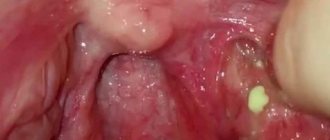White plaque formed on the tonsils is not a disease, but indicates problems in the body.
This symptom is characteristic of various diseases; it is almost impossible to determine independently at home. Therefore, if this symptom is detected, you should consult a doctor, especially if this concerns children, even if the patient does not have a fever.
What are white dots on the tonsils
Plaque can take the form of single white dots of varying sizes - from one to several millimeters. Their consistency can be soft, cheesy (caseous), dense or hard.
Every day, the tonsils encounter microbes that enter through the nasopharynx. In the lacunae, pathogenic microorganisms come into contact with the epithelium of the tonsils. In response to the penetration of bacteria, local inflammation develops. It activates the immune system and the production of antibodies.
The epicenter of resistance to infection is the follicles of the tonsils. They are groups of lymphoid immunocompetent cells. The result of the struggle is accumulation of destroyed cells and bacteria in the lacunae and at the site of the follicles. Gradually the plugs are impregnated with calcium salts and harden.
The resulting white dots on the tonsils consist of:
- from the remains of dead leukocytes;
- destroyed epithelial cells;
- microbes;
- calcium salts.
Bacterial examination of the contents of plugs reveals streptococci, staphylococci, and pneumococci.
What kind of disease is this and what are its causes?
Chronic tonsillitis is the most common cause of plug formation.
In addition, white lumps on the tonsils may appear:
- with weakened immunity;
- frequent sore throats;
- herpetic infection;
- fungal infection - candidiasis;
- caries;
- viral infections - influenza, ARVI.
With and without fever
The appearance of white spots on the tonsils may be accompanied by an increase in temperature. This is observed:
- with follicular or lacunar tonsillitis;
- influenza and acute respiratory viral diseases;
- herpetic infection;
- exacerbation of chronic tonsillitis.
The tonsils enlarge, their hyperemia and swelling are revealed, their surface loosens.
White spots on the tonsils may appear without fever. This happens:
- with candidiasis;
- with chronic tonsillitis without exacerbation.
To establish the cause of white dots on the tonsils, it is necessary to do a bacteriological analysis of them.
White lumps with an unpleasant odor
With chronic tonsillitis, white lumps with an unpleasant odor appear in the tonsils. They often have a cheesy or hard consistency. They are called tonsilloliths. The putrid odor is caused by the activity of pathogenic microorganisms. The disease occurs without sore throat.
With inflammatory processes in the throat or nasopharynx, tonsillitis increases.
Other symptoms
With exacerbation of chronic tonsillitis, follicular or lacunar tonsillitis, in addition to plaque on the tonsils, there is a sore throat, difficulty swallowing, enlargement and tenderness of the submandibular lymph nodes. Symptoms of intoxication appear: headache, weakness, lack of appetite. At night there may be heavy sweats and sleep disturbances.
With acute respiratory viral infections, patients complain of body aches, pain in the muscles and when moving the eyeballs, cough, runny nose, and chest congestion.
What is white plaque?
White plaque may consist of dead or pathogen-damaged epithelial cells. We can detect similar “pellets” if we thoroughly rub clean skin with a washcloth.
The top layer of epithelium will separate and become white.
Normally, the mucous membrane has a pink or reddish color, due to the blood vessels that nourish its cells. If their work is disrupted, the blood supply stops. Also, a white coating can be formed by pus that has dried on the surface of the throat. This occurs with lacunar tonsillitis and other diseases caused by pyogenic microorganisms (staphylococci, streptococci, etc.). This is precisely the nature of the white coating most often.
In rare cases, colonies of pathogenic microorganisms that appear on the organs and tissues of the throat themselves are white, as is the case with the fungus Candida albicans.
After ARVI in a child
Children suffer from acute respiratory viral diseases quite often. This is due to:
- immaturity of the child’s immune defense mechanisms;
- high crowding in children's groups.
Sometimes after an acute respiratory viral infection, white dots or spots are found on the child’s tonsils, enlargement, swelling of the tonsils, and redness of the palatine arches. This indicates the addition of a bacterial infection and the development of a sore throat. In this case, you should immediately seek medical help.
Timely and correct treatment of sore throat will protect the child’s body from complications.
A white coating may appear on the child’s tonsils without fever. This happens when oral thrush occurs. Thrush is a fungal disease caused by pathogenic fungi of the genus Candida. Candidiasis often develops during antibiotic treatment. The diagnosis is made based on examining a smear from the tonsil under a microscope. Specific antifungal drugs are used in treatment.
Traditional methods
White spots in the throat of an adult or child can be eliminated using traditional medicine recipes. Inhalation and taking certain products will help with this:
- Treatment with honey. If there are no allergic reactions to this product, place a teaspoon of honey on the tip of your tongue and hold until it begins to melt. Repeat the procedure every hour.
- Garlic therapy. Chew a clove of garlic every two hours so that the juice released kills the bacteria that caused the plaque.
- Onion inhalations. Grind the onion into a puree, lean over the bowl and inhale with your mouth. Deep breaths should be taken for five minutes, repeated 2-3 times a day.
Gargling with decoctions
A white coating on the throat without fever indicates the presence of tonsillitis, pharyngitis or laryngitis. Rinsing with infusions of medicinal herbs will help you cope with it:
- Chamomile decoction. Pour a tablespoon of chamomile flowers into a glass of boiling water, hold for 20 minutes and gargle 2-3 times a day.
- Calendula decoction. Dry raw materials in the amount of 1.5 tablespoons, pour 1.5 cups of boiling water, keep in a water bath for 15 minutes and cool to room temperature. Rinse 3-4 times a day.
- Sage decoction. Brew a teaspoon of raw material with half a glass of hot water, let it brew for half an hour. Rinse 2-3 times/day.
How to remove white dots
In order to remove white lumps in the tonsils, use local antiseptic bactericidal agents. They are available in a wide range in the form of sprays, lozenges or tablets. Rinsing helps a lot. Traditionally, solutions of soda, table salt with iodine, furatsilin, chamomile and sage decoctions are used for this. You can use a solution of Metrogyl, Miramistin.
It is impossible to clean the tonsils from white lumps at home. This is done by an otolaryngologist by vacuum extraction of plugs or washing the tonsils with antiseptic solutions.
It is not recommended to remove a white dot containing pus from the tonsil on your own. In the acute period of the disease, this is prohibited.
Causes of white plaque in the throat
The symptom may occur as a result of the following diseases or conditions:
- Oropharyngeal burn or exposure to other damaging factors (acids, alkalis, poisons). In this case, the plaque is rarely accompanied by signs of fever - fever, muscle aches, and increased fatigue. Also, a white coating in the throat can be the result of smoking.
- Atrophy of the mucous membrane. It occurs against the background of various diseases, but always comes down to the progressive death of the epithelium. In addition to white plaque, mucus and dried crusts (growths) of pus may be observed.
- Angina. Plaque is easily separated from the surface of the tonsils, without damaging the mucous membrane. It resembles small white lumps in the throat, unlike diphtheria, when there is extensive damage to the mucous membrane. The disease is accompanied by a sore throat, sometimes high fever, and signs of intoxication.
- Infectious mononucleosis. It is believed to be a viral disease that affects a number of organs. Plaques on the surface of the tonsils and palatine arches resemble those of sore throat, but do not go away much longer - up to several weeks.
- Diphtheria. A dirty white plaque, tightly adhered to the mucous membrane of the oropharynx, is one of the characteristic signs of the disease. Diphtheria occurs with high fever and severe headache.
- Precancerous conditions preceded by leukoplakia. They appear in the oral cavity and pharynx in the form of an inseparable whitish film, light warts or various erosions and ulcers. Usually, in such conditions, the throat does not hurt, and there are no other signs of an infectious disease of the oropharynx.
Correct treatment
For the treatment of sore throat, or exacerbation of chronic tonsillitis, in an adult the following is prescribed:
- Broad-spectrum antibiotics.
- Irrigation or washing of the tonsils with an antiseptic solution.
- Gargling with bactericidal agents.
- Complex vitamin therapy to improve immunity.
- Physiotherapy.
White lumps on the tonsils are removed by vacuum cleaning the tonsils.
Accurate fulfillment of all doctor’s orders contributes to a quick recovery. Incorrect or self-treatment can lead to the development of complications.
Folk remedies
The use of folk remedies to remove white plaque is possible only in cases of layering of food residues or mechanical damage to the mucous membrane. For other diseases, recipes based on medicinal plants and bee products are used as an auxiliary treatment, and cannot replace drug therapy with them.
The following recommendations are effective and safe:
- Freshly brewed tea strengthens the immune system, has an anti-inflammatory and wound-healing effect
gargling with symptoms of sore throat at the initial stage of its development with beetroot broth (inhibits the growth of bacteria);
- solution from crushed furatsilin tablets or 1 tsp. will help reduce pain and stop the division of bacteria when rinsing (every 30-60 minutes);
- Honey has an antibacterial effect (dissolve a teaspoon every 1.5 hours);
- chewing a clove of garlic every 2 hours (significantly reduces the number of bacteria);
- sucking a slice of lemon in the mouth (do not sweeten or salt it, you can injure the mucous membrane).
Important! When using folk remedies, it is worth considering that their action is effective at the initial stage of the development of the disease; in an aggravated form, it is necessary to carry out full-fledged therapy.
The treatment process can be supplemented with such a pleasant procedure as drinking tea. Thanks to the healing drink, it has an effect in several directions at once: strengthening the immune system, anti-inflammatory and wound healing.
The following teas and decoctions are considered the most effective:
- infusion of chamomile and calendula (in equal proportions);
- fruit drinks from black currants and cranberries;
- rosehip decoction;
- infusion of sage leaves and St. John's wort;
- milk (warm) with honey.
What complications can occur if left untreated?
The presence of a chronic source of infection in the body can lead to the spread of pathogenic microorganisms and damage to other organs. Most often they suffer from this:
- kidneys;
- joints;
- heart.
If an abscess is present or an open wound is formed when trying to remove the plugs mechanically, microbes are able to penetrate the bloodstream. This is fraught with the development of sepsis - blood poisoning, which in half of all cases leads to the death of the patient, even with timely seeking medical help.
The lack of treatment for diphtheria and untimely administration of anti-diphtheria serum is fraught with the development of severe damage to the nervous system and death of the patient.
How to treat white lumps in the throat
A small number of white dots on the tonsils indicates chronic tonsillitis. In order to avoid the occurrence of putrid odor from the mouth and the “growth” of plaques, it is necessary to undergo a set of procedures prescribed by an ENT doctor twice a year. Paying attention to your health will help you avoid serious complications.
The method of relieving the disease entirely depends on the cause of the appearance of white balls on the tonsils. For example, if we are talking about infection of the tonsils with bacteria, then the disease cannot be cured without taking antibiotics.
To determine which antibacterial medicine will be the most effective, it is necessary to undergo an analysis of the resistance of the pathogen to different groups of agents. That is why you cannot independently choose a drug for treatment, as well as determine the dosage. This should be done exclusively by an ENT doctor.
Drug therapy
Depending on the results of laboratory tests, the patient is prescribed one of the following drugs:
- Clarithromycin.
- Amoxicillin.
- Cefoperazone.
- Augmentin.
To treat an advanced disease, several drugs that have an antibacterial effect may be prescribed at once.
To effectively get rid of white lumps that appear on the tonsils due to chronic tonsillitis, it is necessary to combine antibiotics with the following drugs:
- Products with a disinfecting effect. The most popular are Chlorhexidine and Dioxidine. You can also rinse your mouth with herbal infusions (sage, chamomile).
- During the period of exacerbation of the chronic form of the disease, the doctor prescribes anti-inflammatory drugs: Panadol, Nurofen. Sometimes doctors advise taking homeopathic remedies. The most popular - Tonsilton - has no side effects and is recommended for the treatment of tonsillitis in children.
- Taking vitamin complexes. The inflammatory process affects the entire body, but the immune system is particularly damaged. To get rid of dizziness, poor health and improve the functioning of the immune system, you need to diversify your diet and take vitamins, the composition of which is replete with basic micro and macroelements, useful substances necessary for the normal functioning of all organs and systems.
Physiotherapeutic treatments
In addition to taking medications and gargling, it is recommended to undergo a course of physiotherapeutic procedures. Their type and duration are determined by the attending ENT doctor. The following types of physiotherapy are distinguished:
- ultrasonic;
- microwave therapy;
- UHF;
- laser irradiation.
Local therapy
Washing the tonsils
Quite often, experts prescribe medications for resorption (Septolete or Hexalize) and recommend taking a course of procedures for washing the lacunae of the tonsils. This manipulation is extremely difficult to do at home without experience, so it is better to take a course from a doctor.
Traditionally, the otolaryngologist prescribes 10–15 procedures; for rinsing, the specialist uses a copper-silver solution, which has a disinfecting effect.
In advanced forms of tonsillitis, even after several courses of traditional drug treatment, lumps with or without pus continue to appear on the tonsils. For some patients, the doctor may suggest removal of the tonsils. After a surgical procedure called tonsillectomy, the patient will no longer be bothered by tonsil plugs.
Purulent plugs in the throat in children and adults
In children of younger and older age categories, sore throat can often be observed with purulent plugs in the throat. Follicular and lacunar tonsillitis is marked by yellow and white purulent plugs; blisters with pus cover almost all the tonsils. The disease is accompanied by headaches, fever, general weakness, and loss of appetite. There are strong changes in the blood test, they are associated with a high content of leukocytes.
If there is suddenly a suspicion of diphtheria sore throat, the sick child should be hospitalized immediately. This disease is very dangerous with all sorts of complications in the future. Diphtheria is marked by purulent gray deposits, which cause great pain when removed. Suspicion of such a disease may arise already at the first examinations.
Parents often have questions about tonsil removal; such advice can only be given by the attending physician. Often, a child can simply “outgrow” tonsil disease, but if there is a serious risk of complications in the heart, joints and kidneys, then it is worth consulting with experienced specialists before making a decision.
Adult patients often turn to the doctor with the same questions about purulent plugs in the throat. A person constantly suffers from sore throat, pharyngitis, and purulent plugs in the throat are caused by the same diseases. Reduced immunity, poor environmental conditions, improper self-medication - all this causes chronic tonsillitis (chronic inflammation of the tonsils). With periodic exacerbations, chronic tonsillitis manifests itself as sore throat. The constant appearance of purulent plugs in the throat and bad breath bring anxiety and exhaust the patient.
An extremely dangerous complication is in the form of a peritonsillar abscess, which turns into phlegmon of the neck, which threatens the patient in case of negligence in the treatment of chronic tonsillitis. Diseases of the joints, heart and kidneys are very dangerous, as complications after previous diseases associated with the presence of purulent plugs in the throat.
Preventive measures
Most often, white plaque signals a decrease in the body’s immune function and the beginning of an inflammatory process. Hypothermia or heavy exercise can trigger an exacerbation.
To prevent this effect, it is recommended to maintain physical fitness with basic morning exercises. You should choose clothes in accordance with the season and weather conditions.
After the end of the summer season, it is appropriate to take complex vitamin formulations that will prevent a decrease in protective functions.
You can compensate for the deficiency of microelements necessary for normal life by including a large amount of vegetables, fruits, fish and meat (low-fat varieties) in your diet.
Is it possible to remove purulent plugs on the tonsils yourself?
Sometimes patients make attempts to remove all stones and plaques on their own so that their breath does not stink. But doctors warn that getting rid of tonsil blockages at home is fraught with serious consequences. By wielding a foreign object, the patient can disrupt the integrity of the lacunae and cause an infection in the throat.
At home, you can perform inhalations with compounds that have anti-inflammatory and disinfecting properties. To combat white formations on the tonsils, it is recommended to use herbal preparations, with which you can rinse your mouth or carry out inhalations. To increase efficiency, you can add cedar essential oil to the inhaler.
If white lumps on your tonsils don’t give you peace, you can try to get rid of them in several safe ways:
- Sometimes the plugs “come out” of the gaps if you press on them with your tongue. After the procedure, be sure to rinse your mouth.
- You can try removing the plugs with a soft-bristled toothbrush.
White balls in the throat and tonsils indicate inflammation in the pharynx, so it is recommended to consult a doctor as soon as possible to clarify the diagnosis and prescribe a treatment regimen. Remember that manipulations carried out at home do not guarantee getting rid of white formations in the throat and relieving chronic tonsillitis.








